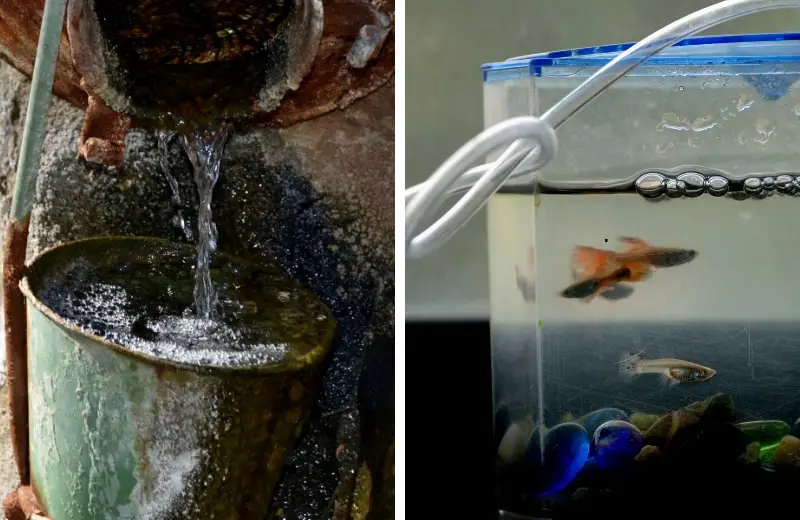Are you tired of spending a fortune on bottled water to keep your aquarium clean and healthy? Well, why not consider using well water instead? With the right treatment, well water can be a great source of freshwater for your aquarium.
However, treating well water for aquarium use can be a bit tricky. There are various factors to consider, such as the pH balance, mineral content, and the presence of contaminants. In this article, we’ll guide you through the process of treating your well water to ensure your aquarium thrives in a clean and healthy environment.
If you plan to use well water for your aquarium, you need to treat it first. Here are the steps to follow:
- Test the water to know its quality. You can use a test kit or take a sample to a lab.
- Install a water softener if the water is hard.
- Install a reverse osmosis (RO) filter to remove impurities.
- Use a dechlorinator to remove chlorine and other chemicals.
- Add aquarium salt to balance the water chemistry.
By following these steps, you can ensure your fish have a healthy environment to live in.

How to Treat Well Water for Aquarium
Aquariums are beautiful additions to any home or office, but they require careful maintenance to keep the fish healthy and happy. One of the most important aspects of aquarium maintenance is ensuring the water is clean and safe for the fish to live in. If you have well water, you may need to take extra steps to ensure it’s safe for your aquatic pets. In this article, we’ll discuss how to treat well water for aquariums.
Understanding Well Water
Well water is a natural source of water that comes from the ground. It’s often used in rural areas where municipal water isn’t available. Well water can contain a variety of minerals, such as iron, calcium, and magnesium, which can be harmful to fish if not properly treated.
To determine if your well water is safe for aquarium use, you’ll need to have it tested. You can purchase a water testing kit online or at a pet store. The kit will test for pH, ammonia, nitrite, nitrate, and other important parameters. Once you know what’s in your well water, you can take steps to treat it.
Filtering Well Water
One of the easiest ways to treat well water for aquarium use is to filter it. There are several types of filters available, including carbon filters, reverse osmosis filters, and deionization filters. Each type of filter removes different types of impurities, so it’s important to choose the right one for your needs.
Carbon filters are the most common type of filter and are effective at removing chlorine, sediment, and volatile organic compounds (VOCs) from the water. Reverse osmosis filters remove a wider range of impurities, including bacteria, viruses, and heavy metals. Deionization filters are used to remove minerals and other dissolved solids from the water.
Using Water Conditioners
Water conditioners are another option for treating well water for aquarium use. These products contain chemicals that neutralize chlorine and chloramine, which are often found in municipal water supplies. They can also detoxify heavy metals and other harmful substances.
When using water conditioners, it’s important to follow the instructions carefully. Overdosing can be harmful to the fish and may cause the water to become cloudy. Be sure to test the water regularly to ensure the conditioners are working properly.
Reducing Mineral Content
If your well water has a high mineral content, you may need to take additional steps to treat it. One option is to use a water softener, which removes minerals like calcium and magnesium from the water. Another option is to use a mineral-reducing filter, which uses resins to remove minerals from the water.
It’s important to note that some minerals, like calcium, are actually beneficial for fish and other aquatic life. Be sure to research the specific needs of your fish species before reducing the mineral content of the water.
Adding Beneficial Bacteria
Beneficial bacteria are essential for maintaining a healthy aquarium environment. These bacteria break down waste products and help to keep the water clean and clear. If your well water doesn’t contain enough beneficial bacteria, you can add it using a bacterial supplement.
Bacterial supplements are available in liquid or powder form and can be added directly to the aquarium water. Be sure to follow the instructions carefully and monitor the water quality regularly.
Conclusion: Well Water Treatment for Aquariums
Treating well water for aquarium use requires careful consideration of the water’s mineral content, pH, and other parameters. By using filters, conditioners, and beneficial bacteria, you can ensure your fish are living in a safe and healthy environment. Regular water testing and monitoring is essential for maintaining the health of your aquatic pets.
Frequently Asked Questions
Here are some commonly asked questions about how to treat well water for aquarium:
What are some common problems with using well water in an aquarium?
Well water can contain high levels of minerals such as calcium, magnesium, and iron, which can affect the water chemistry of your aquarium. Additionally, well water may contain harmful contaminants such as pesticides, herbicides, and heavy metals that can be harmful to aquatic life.
To ensure the health and well-being of your aquarium inhabitants, it is important to properly treat your well water before using it in your aquarium.
What steps should I take to treat my well water for my aquarium?
The first step in treating well water for your aquarium is to test the water to determine its mineral content and pH levels. Once you have this information, you can choose the appropriate treatment method, which may include using a water softener, reverse osmosis filtration, or adding chemical treatments such as activated carbon or a dechlorinator.
It is important to follow the manufacturer’s instructions carefully when using any water treatment method and to regularly test your aquarium water to ensure that the water chemistry remains stable and safe for your fish and other aquatic life.
Can I use well water in a saltwater aquarium?
If you have a saltwater aquarium, it is important to ensure that your well water is properly treated to remove any minerals or contaminants that could affect the delicate balance of your aquarium’s water chemistry. This may require using a combination of water softening, filtration, and chemical treatments to ensure that your well water is safe and suitable for your saltwater aquarium inhabitants.
It is also important to regularly test your aquarium water and to monitor the health and behavior of your fish and other aquatic life to ensure that they are thriving in their environment.
What are some signs that my well water is not suitable for my aquarium?
Some common signs that your well water may not be suitable for your aquarium include changes in water color or odor, excessive algae growth, and the presence of dead or sick fish or other aquatic life.
If you notice any of these signs, it is important to test your water for contaminants and to take immediate steps to address any issues that are identified.
How often should I test my well water for my aquarium?
It is recommended to test your well water for aquarium use at least once per month, or more frequently if you notice any changes in water quality or if you add new fish or other aquatic life to your aquarium.
Regular water testing can help you identify and address any issues with your well water before they become a problem for your aquarium inhabitants, and can help you maintain a healthy and thriving aquarium ecosystem.

The downside to using well water for your fish
In conclusion, treating well water for aquariums is essential for the health and well-being of your aquatic pets. By following the steps outlined in this guide, you can ensure that your well water is free from harmful contaminants and safe for your fish to thrive in.
Remember to test your well water regularly and adjust your treatment methods accordingly. It’s also important to monitor your aquarium’s water quality and make any necessary changes to maintain a healthy environment for your fish.
Overall, taking the time to treat your well water properly can help you create a beautiful and thriving aquarium that you and your fish will enjoy for years to come. So, don’t hesitate to start implementing these tips and tricks today!
